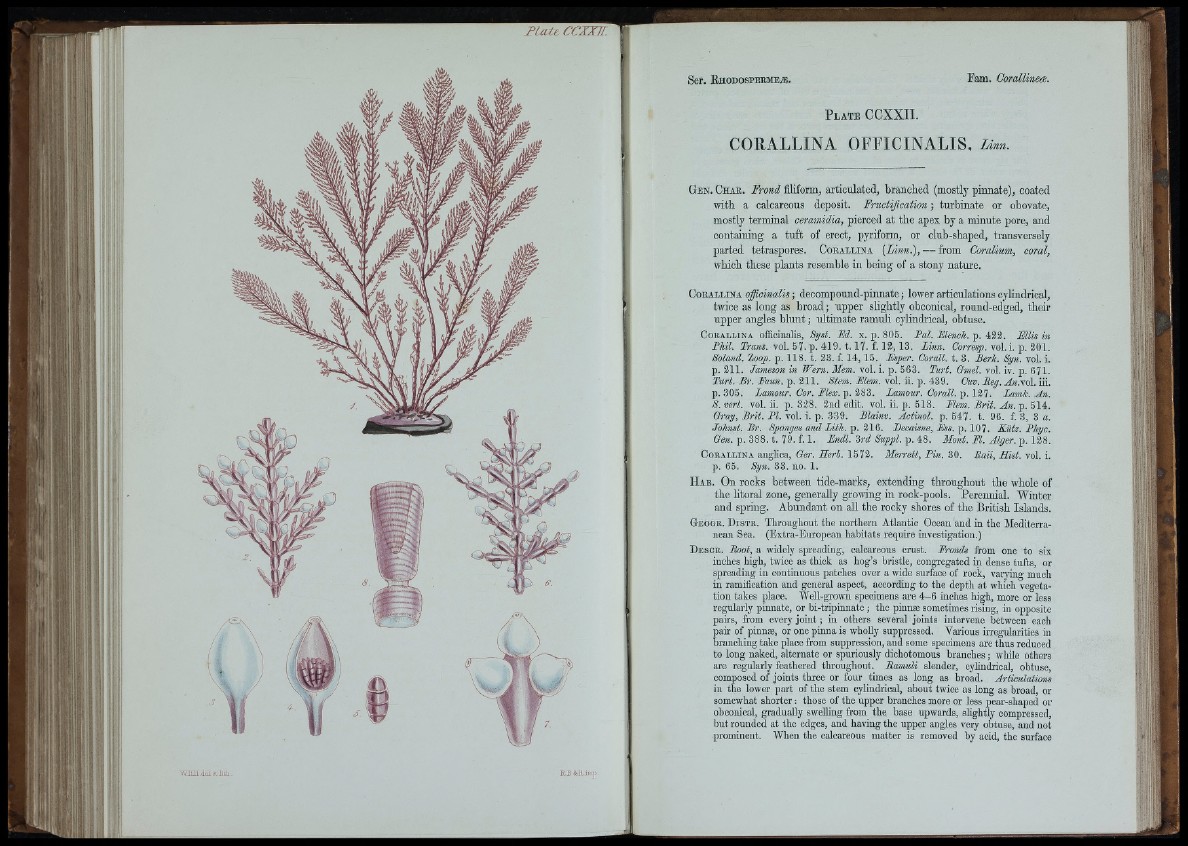
WJUi.del et Mi
P late C C X X I I .
CORALLINA OFFICINALIS, Linn.
G e n . C h a e . Frond filiform, articulated, branched (mostly pinnate), coated
with a calcareous deposit. Fruetifieation; turbinate or obovate,
mostly terminal ceramidia, pierced at the apex hy a minute pore, and
containing a tuft of erect, pyriform, or club-shaped, transversely
parted tetraspores. C o e a l l i n a [Linn.), — from Coralium, coral,
which these plants resemble in being of a stony nature.
C o e a l l i n a officinalis ; decompound-pinnate ; lower articulations cylindrical,
twice as long as broad ; upper slightly obconical, round-edged, their
upper angles blunt ; ultimate ramuli cylindrical, obtuse.
Coeallina officinalis, Syst. Ed. x. p. 805. Eal. Elench. p. 422. Ellis in
Phil. Trans, vol. 57. p. 419. 1 .17. f. 12,13. Linn. Corresp. vol.i. p. 201.
Soland. Tioop. p. 118. t. 23. f. 1 4,15. Esper. Corali, t. 3. Perk. Syn. vol. i.
p. 211. Jameson in Wern. Mem. vol. i. p. 568. Turt. Gmel. vol. iv. p. 671.
Turt. Br. Eaun. p. 211. Stem. Elem. vol. ii. p. 439. Cm. Reg. An.yol. iii.
p. 305. Lamour. Cor. Elex. p. 283. Lamour. Corali, p. 127. Lamk. An.
S. vert. vol. ii. p. 328. 2nd edit. vol. ii. p. 518. Elem. Brit. An. p. 514.
Gray, Brit. Fl. vol. i. p. 339. Blainv. Actinol. p. 547. t. 96. f. 3, 3 a.
Johnst. Br. Sponges and lAth. p. 216. Becaisne, Ess. p. 107. Kiitz. Phyc.
Gen. p. 388. t. 79. f. 1. Endl. 3rd Suppl. p. 48. Mont. El. Alger, p. 128.
Coeallina anglica, Ger. Herb. 1572. Merrett, Pin. 30. Raii, Hist. vol. i.
p. 65. Syn. 33. no. 1.
H a b . On rocks between tide-marks, extending throughout the whole of
the litoral zone, generally growing in rock-pools. Perennial. Winter
and spring. Abundant on aR the rocky shores of the British Islands.
Geoge. Dis t e . Throughout the northern Atlantic Ocean and in the Mediterranean
Sea. (Extra-European habitats requhe investigation.)
Desce. Boot, a widely spreading, calcareous crust. Fronds from one to six
inches high, twice as thick as hog’s bristle, congregated in dense tufts, or
spreading in continuous patches over a wide surface of rock, varying much
in ramification and general aspect, according to the depth at which vegetation
takes place. WeU-growu specimens are 4 -6 inches high, more or less
regularly pinnate, or bi-tripinnate ; the pinnæ sometimes rising, in opposite
pairs, from every joint ; in others several joints intervene between each
pair of pinnæ, or one pinna is wholly suppressed. Various irregularities in
branching take place from suppression, and some specimens are thus reduced
to long naked, alternate or spuriously dichotomous branches ; while others
are regularly feathered throughout. Bamuli slender, cylindrical, obtuse,
composed of joints three or four times as long as broad. Articulations
in the lower part of the stem cylindiical, about twice as long as broad, or
somewhat shorter : those of the upper branches more or less pear-shaped or
obconical, graduaUy sweUing from the base upwards, sHghtly compressed,
but rounded at the edges, and having the upper angles very obtuse, and not
prominent. When the calcareous matter is removed by acid, the surface